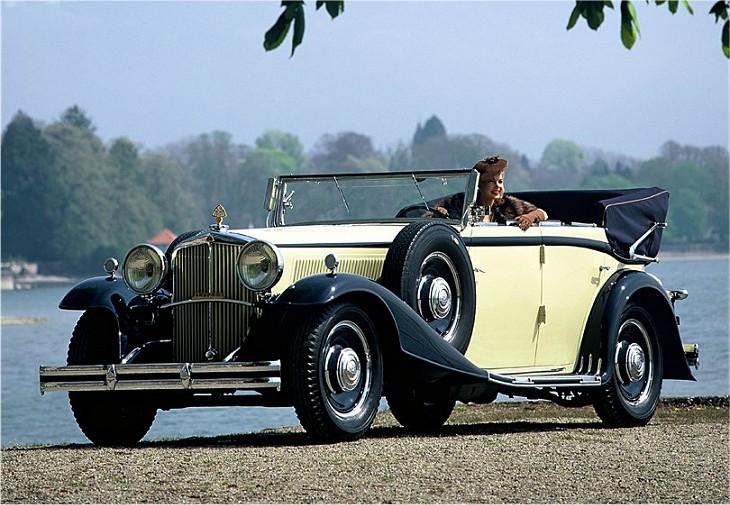Description
The Maybach DS 8 Zeppelin, introduced in 1931, was one of the most extraordinary luxury automobiles ever built, not just in Germany but anywhere in the world. It represented the pinnacle of Maybach’s pre-war engineering and stood as a symbol of uncompromising prestige, technical ambition and bespoke craftsmanship. Larger, more powerful and more refined than the earlier DS 7, the DS 8 was designed for the wealthiest and most influential clients of the early 1930s — heads of state, industrial magnates and aristocrats who demanded the very finest motorcar available.
At the heart of the DS 8 was its legendary 8.0-litre V12 engine. This was a masterpiece of engineering, directly descended from Maybach’s experience in constructing aircraft and airship powerplants. Producing roughly 200 horsepower, it was one of the most powerful automotive engines of its era and delivered immense torque at low revs. Its character was defined by remarkable smoothness, near-silent operation and effortless power delivery. Even with the heaviest custom bodies, the DS 8 accelerated with quiet authority and maintained high cruising speeds with almost unshakeable composure. Few cars of the early 1930s could match the refinement or engineering sophistication of this enormous V12.
The chassis of the DS 8 was engineered to the highest standard. A massive ladder-type steel frame provided exceptional rigidity, necessary for supporting the formal, often very heavy, coachwork typically fitted to the chassis. Suspension consisted of long semi-elliptic leaf springs designed purely for comfort and stability. This gave the DS 8 a dignified, floating ride and made it ideally suited to long-distance touring on the imperfect roads of the period. Steering was steady and precise for a car of its size, and braking — handled by large mechanical drums — was strong for the standards of its time.
To manage such a large, powerful engine, Maybach equipped the DS 8 with its advanced dual-range transmission. This system offered both high and low gearing ranges, allowing the driver or chauffeur to move smoothly from slow, controlled city driving to fast open-road travel. Although not as sophisticated as the Wandler torque-converter transmissions used on Maybach’s later SW models, the DS 8’s gearbox was far ahead of most contemporaries in refinement and gave the car an unusually flexible, effortless driving character.
As with all Maybachs of the period, the DS 8 was sold primarily as a chassis, intended for custom bodies built by Germany’s finest coachbuilders. Spohn of Ravensburg was the most frequent collaborator, though elite workshops such as Erdmann & Rossi and occasionally others also produced magnificent bodies for the DS 8. Limousines, Pullman-Limousines, Town Cars, Cabriolets and Sport Cabriolets were all commissioned, each one unique and hand-crafted to the customer’s precise demands. Bodywork typically featured sweeping fenders, imposing proportions and flawlessly executed metalwork, paint and detailing.
Inside, the DS 8 offered an unmatched level of luxury. Rear compartments in limousine and Pullman configurations were trimmed with the finest leather or tailored wool cloth, complemented by polished hardwood veneers, machined metal fittings and deep carpeting. Amenities such as fold-out writing desks, vanity sets, smoking accessories, interior lighting arrangements, heater units, division windows, intercoms and bespoke cabinetry were common. Every detail was custom, from the seat stitching to the door handles, reflecting the status of the buyers and the extraordinary craftsmanship of the builders.
On the road, the DS 8 delivered a sense of calm, unhurried grandeur. The enormous V12 moved the car with quiet strength, while the long wheelbase and carefully tuned suspension ensured a serene ride. Whether chauffeur-driven or owner-driven, the car felt stable, confident and mechanically refined in a way few other cars of the 1930s could match. It was, by any standard, one of the greatest long-distance luxury vehicles of its era.
Production of the DS 8 Zeppelin was extremely limited due to its vast cost and the economic challenges of the early 1930s. Only a small number of chassis were ever completed, and each one was fitted with bespoke coachwork. Surviving examples today are incredibly rare and are considered museum-grade automobiles — some of the finest and most historically significant luxury cars ever produced.
The Maybach DS 8 Zeppelin remains a towering achievement in automotive history. With its monumental V12 engine, advanced engineering, exquisite craftsmanship and imposing presence, it stands as the ultimate expression of pre-war German luxury motoring. Regal, powerful and meticulously constructed, it represents the absolute peak of Maybach’s pre-war philosophy: engineering excellence without compromise.
